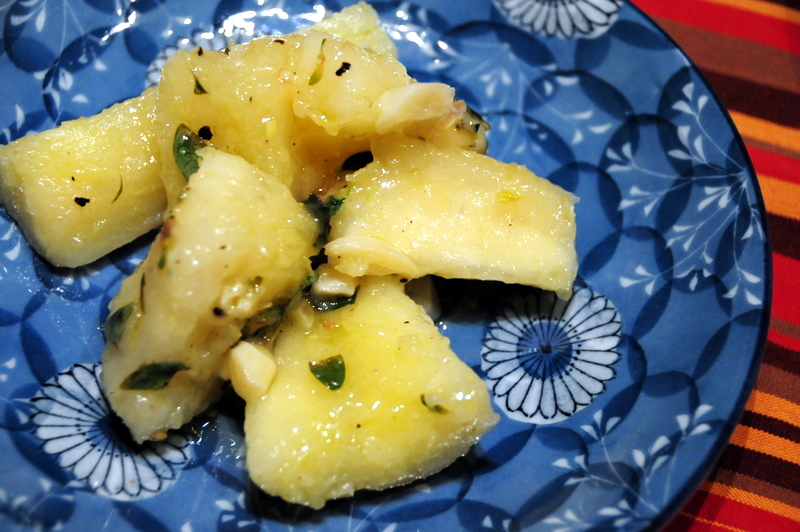Recently, I’ve seen a couple of articles about cassava; one in The Economist, and another in Saveur. The latter is a report on a cassava crop disease in Africa and how devastating it is to the poor because they rely on this tuber as a staple for their main source of carbohydrates. The former is about its versatility. You can process it in many ways to either increase shelf life or to further its use for lots more delicious dishes.
Originally, cassava comes from the tropical New World. Early settlers learned to eat it with the natives and use it to replace wheat flour. It is quite typical in my home state of Minas Gerais, Brazil. Commonly you’ll see houses in the countryside with cassava growing in people’s backyards. Even though the plant’s sturdy, when uprooted you must eat it ASAP as it spoils in no time. Left in the ground you can just harvest whatever amount you need, whenever you want. Talk about a green technology! This sure beats refrigeration.
Cassava has as sweet and nutty flavor. One way I enjoyed it as a kid was for breakfast. My mother made it into a sort of porridge by boiling it, then mashing it with milk, sugar and a bit of butter for an added yum-factor. I have yet to feature that preparation here. I’ve been putting off because it seems too simple. But simple can be really good, so I need to work on that. If you want a bit more complex, look here, or here, or here.
I’ve adapted this recipe from one called yuca con mojo in a recent edition of Saveur. In English they call it “cassava with garlic and citrus.” I’ve renamed my version in Portuguese:
mandioca ao molho de limão e oregano
garlicky limey cassava
1lb fresh frozen cassava root
5 cloves garlic, peeled and cut into slivers
Kosher salt to taste
3 tbsp fresh oregano, roughly chopped
Juice of 5 Mexican limes
1/3 cup of extra virgin arbequina olive oil
Freshly ground black pepper to taste
Crushed red pepper to taste
Place cassava root in a pot, cover with cold water, bring to a boil and cook for about 25 minutes or until soft. It is ready when the outer part becomes gooey and the inside offers a bit of resistance when you poke it with a fork. Remove from heat, drain, and set aside.
Heat half of the olive oil. Add garlic and poach it for few seconds just enough for the raw garlic aroma to give way. Pour it over the drained cassava. Toss in remaining ingredients. Let sit so flavor will marry. Serve as a side dish.

Comments on this entry are closed.
Very interesting! I’ve never used cassia, but this sounds delicious. I’d love to see the porridge recipe you described.
Hi Karen,
I am sure you will enjoy it. We will soon post some fun recipes with cassava.
H
I second Karen’s vote- would definitely love to see your Mom’s cassavava porridge recipe. Interesting background – I love to read about people’s personal connection to ingredients. Thanks for sharing!
Cassava is very difficult to get here, but it has such wonderful color that I buy it whenever I can. I’d love to see your Mom’s recipe. I hope you have a great evening. Blessings…Mary
I would also love to try this cassava; I wonder if it grows in other parts of the world, like the near east for example! and simple is always good in my book!
Have you ever tried casava simply deep fried like thick french fries with salt and pepper? Its simply awesome. My mother in law has made it a few times for me, and i love the stuff.
*kisses* HH
*Mary you can find fresh frozen cassava at Spanish markets if you have one in your area check it out. I’ve have seen it at Whole Foods and Safeway. They are long, brown and treated with a layer of wax to preserve freshness.
*HH I love fried cassava, it is very popular in Brazil
*Joumana I am not certain it would grow in temperate/Mediterranean climate. I know for sure it’s spread throughout the tropical parts of the planet.
Both the porridge you mention and this dish are also popular in the Caribbean. Just looking at this makes me hungry
Hi Wizzythestick,
Thanks for visiting our blog. Yes cassava rules! I grew up eating it made in all possible ways. Another delicious treat from the tropics 🙂
Cassava looks delicious. Thanks for sharing your recipe.